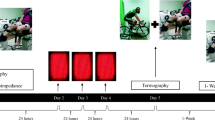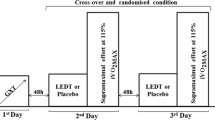Abstract
The purpose of this study was to verify the photobiomodulation therapy (PBMT) effects with different doses on neuromuscular economy during submaximal running tests. Eighteen male recreational runners participate in a randomized, double-blind, and placebo-controlled trial, which each participant was submitted to the same testing protocol in five conditions: control, placebo, and PBMT with doses of 15, 30, and 60 J per site (14 sites in each lower limb). The submaximal running was performed at 8 and 9 km h−1 during 5 min for each velocity. Muscle activation of the vastus lateralis (VL), vastus medialis (VM), rectus femoris (RF), biceps femoris (BF), and gastrocnemius lateralis (GL) was collected during the last minute of each running test. The root mean square (RMS) was normalized by maximal isometric voluntary contraction (MIVC) performed a priori in an isokinetic dynamometer. The RMS sum of all muscles (RMSLEG) was considered as main neuromuscular economy parameter. PBMT with doses of 15, 30, and 60 J per site [33 diodes = 5 lasers (850 nm), 12 LEDs (670 nm), 8 LEDs (880 nm), and 8 LEDs (950 nm)] or placebo applications occurred before running tests. For the statistical analysis, the effect size was calculated. Moreover, a qualitative inference was used to determine the magnitude of differences between groups. Peak torque and RMS during MIVCs showed small effect sizes. According to magnitude-based inference, PBMT with dose of 15 J per site showed possibly and likely beneficial effects on neuromuscular economy during running at 8 and 9 km h−1, respectively. On other hand, PBMT with doses of 30 and 60 J per site showed possible beneficial effects only during running at 9 km h−1. We concluded that PBMT improve neuromuscular economy and the best PBMT dose was 15 J per site (total dose of 420 J).



Similar content being viewed by others
References
Leal Junior EC, Vanin AA, Miranda EF, de Carvalho PT, Dal Corso S, Bjordal JM (2015) Effect of phototherapy (low-level laser therapy and light-emitting diode therapy) on exercise performance and markers of exercise recovery: a systematic review with meta-analysis. Lasers Med Sci 30:925–939
Manteifel VM, Karu TI (2005) Structure of mitochondria and activity of their respiratory chain in successive generations of yeast cells exposed to He-Ne laser light. Biol Bull 32:556–566
Oron U, Ilic S, De Taboada L, Streeter J (2007) Ga-As (808 nm) laser irradiation enhances ATP production in human neuronal cells in culture. Photomed Laser Surg 25:180–182
Ferraresi C, Hamblin MR, Parizotto NA (2012) Low-level laser (light) therapy (LLLT) on muscle tissue: performance, fatigue and repair benefited by the power of light. Photon Lasers Med 1:267–286
Kelencz CA, Muñoz IS, Amorim CF, Nicolau RA (2010) Effect of low-power gallium-aluminum-arsenium noncoherent light (640 nm) on muscle activity: a clinical study. Photomed Laser Surg 28:647–652
Miranda EF, Leal-Junior ECP, Marchetti PH, Dal Corso S (2014) Acute effects of light emitting diodes therapy (LEDT) in muscle function during isometric exercise in patients with chronic obstructive pulmonary disease: preliminary results of a randomized controlled trial. Lasers Med Sci 29:359–365
Lanferdini FJ, Bini RR, Baroni BM, Klein KD, Carpes FP, Vaz MA (2017) Low-level laser therapy improves performance and reduces fatigue in competitive cyclists. Int J Sports Physiol Perform. https://doi.org/10.1123/ijspp.2016-0187
Higashi RH, Toma RL, Tucci HT, Pedroni CR, Ferreira PD, Baldini G, Aveiro MC, Borghi-Silva A, de Oliveira AS, Renno AC (2013) Effects of low-level laser therapy on biceps braquialis muscle fatigue in young women. Photomed Laser Surg 31:586–594
dos Santos Maciel T, Muñoz IS, Nicolau RA, Nogueira DV, Hauck LA, Osório RA, de Paula Júnior AR (2014) Phototherapy effect on the muscular activity of regular physical activity practitioners. Lasers Med Sci 29:1145–1152
Rossato M, Dellagrana RA, Lanferdini FJ, Sakugawa RL, Lazzari CD, Baroni BM, Diefenthaeler F (2016) Effect of pre-exercise phototherapy applied with different cluster probe sizes on elbow flexor muscle fatigue. Lasers Med Sci 31:1237–1244
Toma RL, Tucci HT, Antunes HK, Pedroni CR, de Oliveira AS, Buck I, Ferreira PD, Vassão PG, Renno AC (2013) Effect of 808 nm low-level laser therapy in exercise-induced skeletal muscle fatigue in elderly women. Lasers Med Sci 28:1375–1382
da Silva Alves MA, Pinfildi CE, Neto LN, Lourenço RP, de Azevedo PH, Dourado VZ (2014) Acute effects of low-level laser therapy on physiologic and electromyographic responses to the cardiopulmonary exercise testing in healthy untrained adults. Lasers Med Sci 29:1945–1951
Huang YY, Sharma SK, Carroll J, Hamblin MR (2011) Biphasic dose response in low level light therapy—an update. Dose-Response 9:602–618
Camic CL, Kovacs AJ, Enquist EA, McLain TA, Hill EC (2015) Muscle activation of the quadriceps and hamstrings during incremental running. Muscle Nerve 52:1023–1029
Crozara LF, Castro A, de Almeida Neto AF, Laroche DP, Cardozo AC, Gonçalves M (2015) Utility of electromyographic fatigue threshold during treadmill running. Muscle Nerve 52:1030–1039
Foster C, Lucia A (2007) Running economy: the forgotten factor in elite performance. Sports Med 37:316–319
Saunders PU, Pyne DB, Telford RD, Hawley JA (2004) Factors affecting running economy in trained distance runners. Sports Med 34:465–485
Cadore EL, Pinto RS, Alberton CL, Pinto SS, Lhullier FL, Tartaruga MP, Correa CS, Almeida AP, Silva EM, Laitano O, Kruel LF (2011) Neuromuscular economy, strength, and endurance in healthy elderly men. J Strength Cond Res 25:997–1003
Ache-Dias J, Dellagrana RA, Teixeira AS, Dal Pupo J, Moro AR (2016) Effect of jumping interval training on neuromuscular and physiological parameters: a randomized controlled study. Appl Physiol Nutr Metab 41:20–25
Barnes KR, Kilding AE (2015) Running economy: measurement, norms, and determining factors. Sports Med Open 1:8
Hermens HJ, Freriks B, Merlett R, Stegeman D, Blok J, Rau G, Disselhorst-Klug C, Hägg GM (1999) European recommendations for surface electromyography: results of the SENIAM project. Roessingh Research and Development, Enschede
Batterham AM, Hopkins WG (2006) Making meaningful inferences about magnitudes. Int J Sports Physiol Perform 1:50–57
Johnson MA, Polgar J, Weightman D, Appleton D (1973) Data on the distribution of fiber types in thirty-six human muscles. An autopsy study. J Neurol Sci 18:111–129
Reddy GK (2004) Photobiological basis and clinical role of low-intensity lasers in biology and medicine. J Clin Laser Med Surg 22:141–150
Karu T (1999) Primary and secondary mechanism of action of visible to near-IR radiation on cells. J Photochem Photobiol B 49:1–17
Silveira PC, Silva LA, Fraga DB, Freitas TP, Streck EL, Pinho R (2009) Evaluation of mitochondrial respiratory chain activity in muscle healing by low-level laser therapy. J Photochem Photobiol B 95:89–92
Allen DG, Lamb GD, Westerblad H (2008) Skeletal muscle fatigue: cellular mechanisms. Physiol Rev 88:287–332
Dellagrana RA, Guglielmo LG, Santos BV, Hernandez SG, da Silva SG, de Campos W (2015) Physiological, anthropometric, strength, and muscle power characteristics correlates with running performance in young runners. J Strength Cond Res 29:1584–1591
Souza KM, Vieira G, Baldi MF, Guglielmo LGA, de Lucas RD, Denadai BS (2011) Physiological and neuromuscular variables associated to aerobic performance in endurance runners: effects of the event distance. Rev Bras Med Esporte 17:40–44
Funding
This study was supported in part by National Council for Scientific and Technological Development (CNPq, Brazil).
Author information
Authors and Affiliations
Corresponding author
Ethics declarations
Conflict of interest
The authors declare that they have no conflict of interest.
Research involving human participants
Ethical approval was obtained from the local Human Research Ethics Committee (CAAE: 61599116.1.0000.0121) and the protocol was written in accordance with the standards of the 1964 Declaration of Helsinki and its later amendments.
Informed consent
Informed consent was obtained from all individual participants included in the present study.
Rights and permissions
About this article
Cite this article
Dellagrana, R.A., Rossato, M., Sakugawa, R.L. et al. Dose-response effect of photobiomodulation therapy on neuromuscular economy during submaximal running. Lasers Med Sci 33, 329–336 (2018). https://doi.org/10.1007/s10103-017-2378-4
Received:
Accepted:
Published:
Issue Date:
DOI: https://doi.org/10.1007/s10103-017-2378-4




